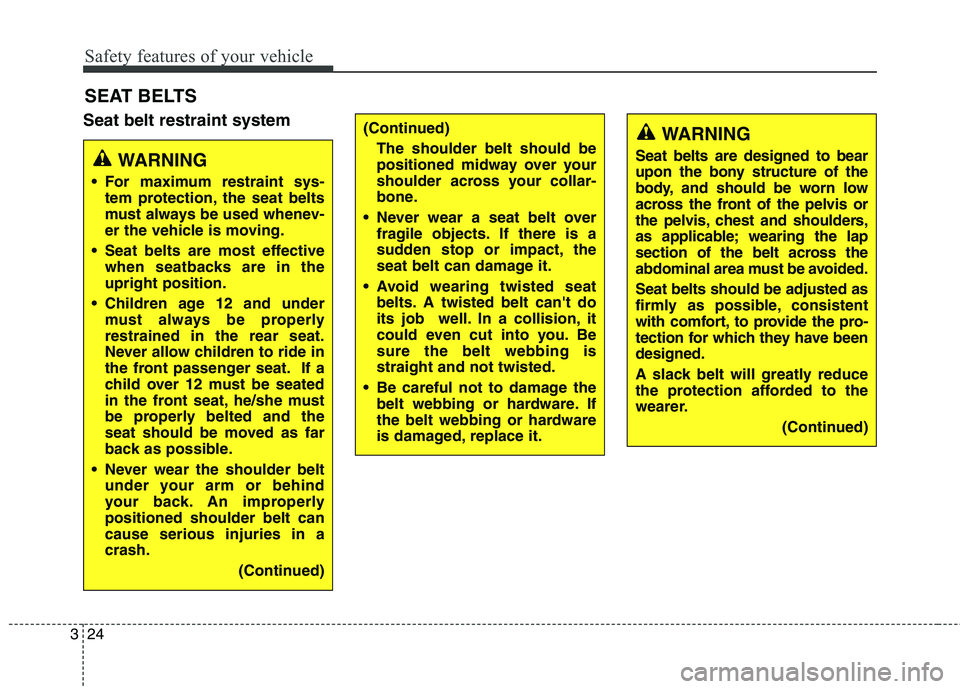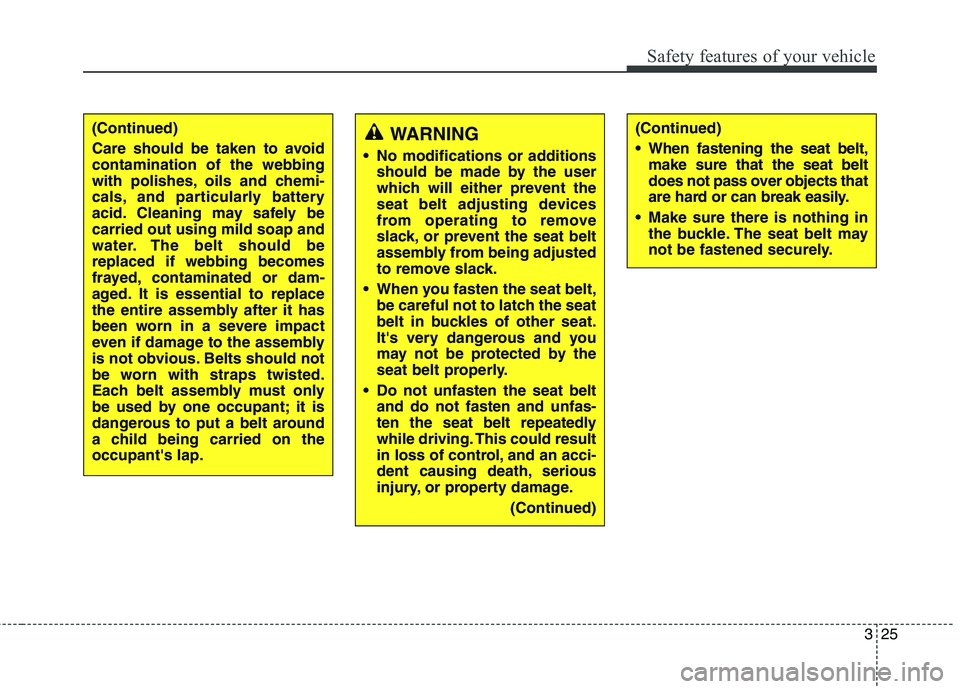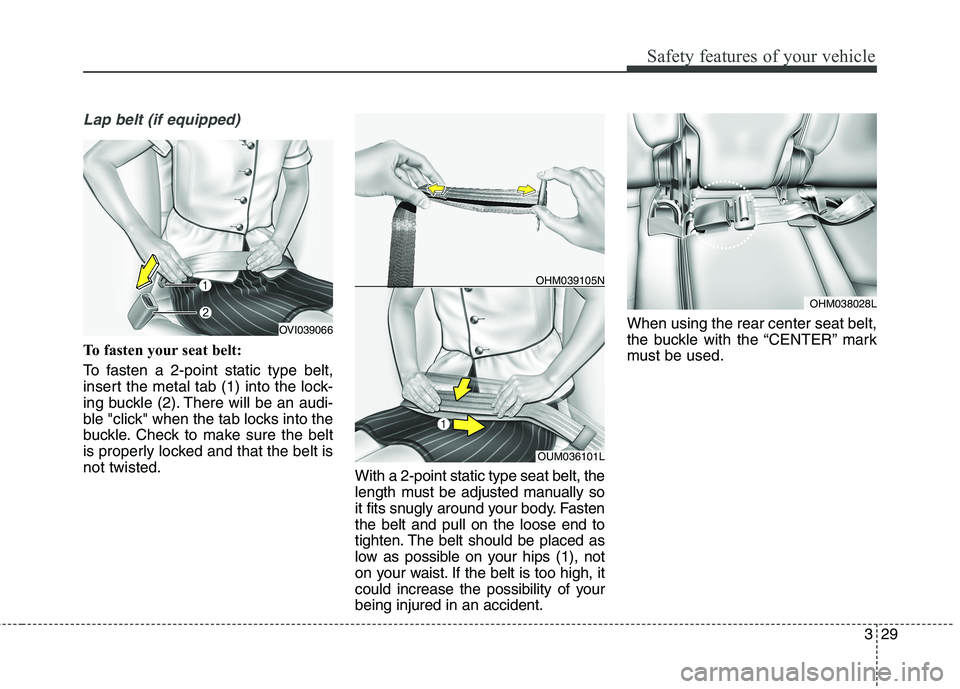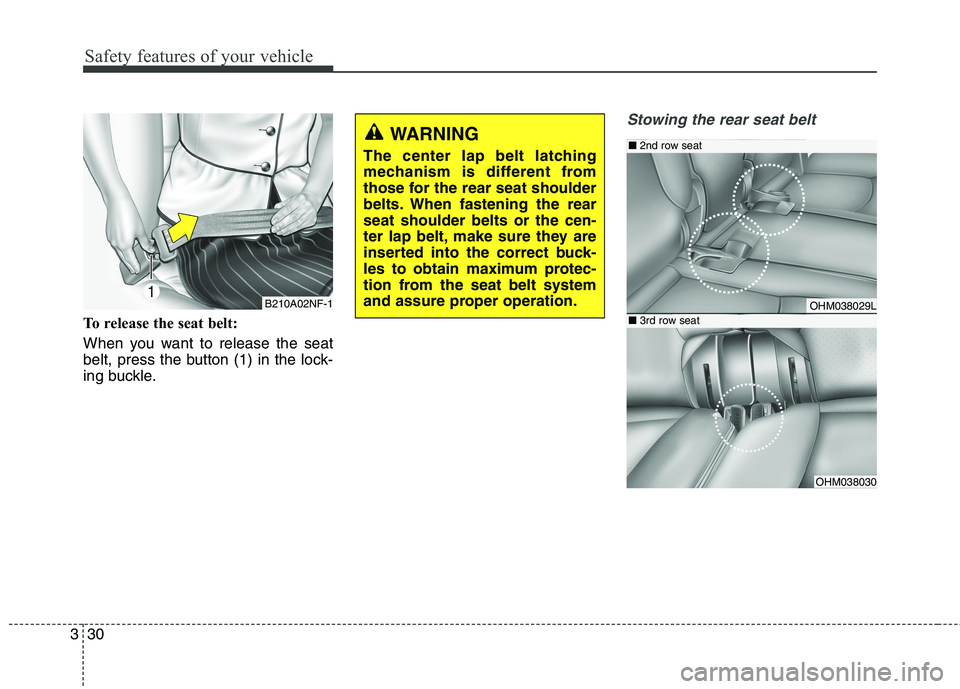KIA BORREGO 2017 Service Manual
Manufacturer: KIA, Model Year: 2017, Model line: BORREGO, Model: KIA BORREGO 2017Pages: 548, PDF Size: 36.78 MB
Page 41 of 548

Safety features of your vehicle
24
3
Seat belt restraint system SEAT BELTS
WARNING
For maximum restraint sys- tem protection, the seat belts
must always be used whenev-
er the vehicle is moving.
Seat belts are most effective when seatbacks are in theupright position.
Children age 12 and under must always be properlyrestrained in the rear seat.
Never allow children to ride in
the front passenger seat. If a
child over 12 must be seated
in the front seat, he/she must
be properly belted and the
seat should be moved as far
back as possible.
Never wear the shoulder belt under your arm or behind
your back. An improperlypositioned shoulder belt cancause serious injuries in acrash.
(Continued)
(Continued)The shoulder belt should be
positioned midway over your
shoulder across your collar-
bone.
Never wear a seat belt over fragile objects. If there is a
sudden stop or impact, the
seat belt can damage it.
Avoid wearing twisted seat belts. A twisted belt can't do
its job well. In a collision, it
could even cut into you. Besure the belt webbing isstraight and not twisted.
Be careful not to damage the belt webbing or hardware. If
the belt webbing or hardware
is damaged, replace it.WARNING
Seat belts are designed to bear
upon the bony structure of the
body, and should be worn low
across the front of the pelvis or
the pelvis, chest and shoulders,
as applicable; wearing the lap
section of the belt across the
abdominal area must be avoided. Seat belts should be adjusted as
firmly as possible, consistent
with comfort, to provide the pro-
tection for which they have beendesigned.
A slack belt will greatly reduce
the protection afforded to the
wearer.
(Continued)
Page 42 of 548

325
Safety features of your vehicle
(Continued)
Care should be taken to avoid contamination of the webbing
with polishes, oils and chemi-
cals, and particularly battery
acid. Cleaning may safely becarried out using mild soap and
water. The belt should bereplaced if webbing becomes
frayed, contaminated or dam-
aged. It is essential to replace
the entire assembly after it has
been worn in a severe impact
even if damage to the assembly
is not obvious. Belts should not
be worn with straps twisted.
Each belt assembly must only
be used by one occupant; it is
dangerous to put a belt around
a child being carried on theoccupant's lap.WARNING
No modifications or additions should be made by the user
which will either prevent the
seat belt adjusting devices
from operating to remove
slack, or prevent the seat belt
assembly from being adjusted
to remove slack.
When you fasten the seat belt, be careful not to latch the seat
belt in buckles of other seat.
It's very dangerous and you
may not be protected by the
seat belt properly.
Do not unfasten the seat belt and do not fasten and unfas-
ten the seat belt repeatedly
while driving. This could result
in loss of control, and an acci-
dent causing death, serious
injury, or property damage.
(Continued)(Continued)
When fastening the seat belt,make sure that the seat belt
does not pass over objects that
are hard or can break easily.
Make sure there is nothing in the buckle. The seat belt may
not be fastened securely.
Page 43 of 548

Safety features of your vehicle
26
3
Seat belt warning
As a reminder to the driver, the seat
belt warning light will illuminate for
approximately 6 seconds each time
you turn the ignition switch ON
regardless of belt fastening.
If the driver’s seat belt is not fastened
when the ignition switch is turned ONor if it is disconnected after the igni-
tion switch is turned ON, the seat
belt warning light will illuminate until
the belt is fastened. If you continue not to fasten the seat
belt and you drive over 9km/h, the
illuminated warning light will start to
blink until you drive under 6km/h.
If you continue not to fasten the seat
belt and you drive over 20km/h the
seat belt warning chime will sound
for approximately 100 seconds and
the corresponding warning light will
blink.
Lap/shoulder belt
Height adjustment
You can adjust the height of the shoul- der belt anchor to one of 4 positions
for maximum comfort and safety. The height of the adjusting seat belt
should not be too close to your neck.
You will not be getting the most effec-
tive protection. The shoulder portionshould be adjusted so that it lies
across your chest and midway over
your shoulder near the door and not
your neck.
To adjust the height of the seat belt
anchor, lower or raise the height
adjuster into an appropriate position.
1GQA2083OHM038027
■
Front seat
Page 44 of 548

327
Safety features of your vehicle
To raise the height adjuster, pull it up
(1). To lower it, push it down (3) while
pressing the height adjuster button (2).
Release the button to lock the
anchor into position. Try sliding the
height adjuster to make sure that it
has locked into position.To fasten your seat belt:
To fasten your seat belt, pull it out of
the retractor and insert the metal tab
(1) into the buckle (2). There will be
an audible "click" when the tab locks
into the buckle. The seat belt automatically adjusts to the proper length only after the lap
belt portion is adjusted manually so
that it fits snugly around your hips. If
you lean forward in a slow, easy
motion, the belt will extend and let
you move around. If there is a sud-
den stop or impact, however, the belt
will lock into position. It will also lock
if you try to lean forward too quickly.✽✽NOTICE
If you are not able to pull out the
seat belt from the retractor, firmly
pull the belt out and release it. Then
you will be able to pull the belt out
smoothly.
WARNING
Verify the shoulder belt anchor is locked into position
at the appropriate height.
Never position the shoulder
belt across your neck or face.
Improperly positioned seatbelts can cause seriousinjuries in an accident.
Failure to replace seat belts after an accident could leave
you with damaged seat belts
that will not provide protec-
tion in the event of another
collision leading to personal
injury or death. Replace yourseat belts after being in an
accident as soon as possible.
B180A01NF-1
Page 45 of 548

Safety features of your vehicle
28
3
When using the rear center seat belt,
the buckle with the “CENTER” mark
must be used. (if equipped) To release the seat belt:
The seat belt is released by pressing
the release button (A) in the locking
buckle. When it is released, the belt
should automatically draw back into
the retractor.
If this does not happen, check the belt to be sure it is not twisted, then
try again.
B200A01NF
WARNING
You should place the lap belt
portion as low as possible and
snugly across your hips, not on
your waist. If the lap belt is locat-
ed too high on your waist, it may
increase the chance of injury in
the event of a collision. Botharms should not be under or
over the belt. Rather, one should
be over and the other under, as
shown in the illustration.
Never wear the seat belt under
the arm near the door.
OHM038028NOUM036100L
Page 46 of 548

329
Safety features of your vehicle
Lap belt (if equipped)
To fasten your seat belt:
To fasten a 2-point static type belt,
insert the metal tab (1) into the lock-
ing buckle (2). There will be an audi-
ble "click" when the tab locks into the
buckle. Check to make sure the belt
is properly locked and that the belt isnot twisted.With a 2-point static type seat belt, the
length must be adjusted manually so
it fits snugly around your body. Fastenthe belt and pull on the loose end to
tighten. The belt should be placed as
low as possible on your hips (1), not
on your waist. If the belt is too high, it
could increase the possibility of yourbeing injured in an accident.When using the rear center seat belt,
the buckle with the “CENTER” mark
must be used.
OVI039066
OHM039105N
OUM036101L
OHM038028L
Page 47 of 548

Safety features of your vehicle
30
3
To release the seat belt:
When you want to release the seat
belt, press the button (1) in the lock-
ing buckle.
Stowing the rear seat belt
B210A02NF-1
WARNING
The center lap belt latching
mechanism is different from
those for the rear seat shoulder
belts. When fastening the rearseat shoulder belts or the cen-
ter lap belt, make sure they are
inserted into the correct buck-
les to obtain maximum protec-
tion from the seat belt system
and assure proper operation.
OHM038029L
OHM038030
■ 2nd row seat
■3rd row seat
Page 48 of 548

331
Safety features of your vehicle
The rear seat belt buckles can bestowed in the pocket between the
rear seatback and cushion when
not in use.
The center seat belt can be stowed with the plate and webbing rolled in
the pocket between the rear seat-
back and cushion.
Routing the seat belt webbingthrough the rear seat belt guides
will help keep the belts from being
trapped behind or under the seats.
After inserting the seat belt, tighten
the belt webbing by pulling it up.CAUTION
When using the seat belt, use it
after taking it out of the guides.
If you pull the seat belt when itis stored in the guides, it maydamage the guides and/or belt webbing.
OHM038031
OHM038032
■ 2nd row seat
■3rd row seat
Page 49 of 548

Safety features of your vehicle
32
3
Pre-tensioner seat belt
Your vehicle is equipped with driver's and front passenger's pre-tensioner
seat belts (retractor pretensioner).The pre-tensioner seat belts can be
activated, where the frontal collision
is severe enough, together with the
air bags.
When the vehicle stops suddenly, or
if the occupant tries to lean forward
too quickly, the seat belt retractor will
lock into position. In certain frontal
collisions, the pre-tensioner will acti-
vate and pull the seat belt into tighter
contact against the occupant's body. - Retractor Pretensioner
The purpose of the retractor pre-
tensioner is to make sure that theshoulder belts fit in tightly againstthe occupant's upper body in cer-
tain frontal collisions.
If the system senses excessive ten-
sion on the driver or passenger'sseat belt when the pre-tensioner sys-
tem activates, the load limiter inside
the retractor pre-tensioner willrelease some of the pressure on the
affected seat belt. (if equipped)✽✽ NOTICE - if equipped with
rollover sensor
The pre-tensioner will activate not
only in a frontal collision but also in
a side collision or rollover, if the
vehicle is equipped with a side or
curtain air bag.
✽
✽ NOTICE - without rollover sensor
The pre-tensioner will activate not
only in a frontal collision but also in a
side collision, if the vehicle is equipped
with a side or curtain air bag.
OED030300
WARNING
For your safety, be sure that the belt webbing is not loose or
twisted and always sit properly
on your seat.
Page 50 of 548

333
Safety features of your vehicle
The seat belt pre-tensioner system
consists mainly of the following com-
ponents. Their locations are shown in
the illustration:
(1) SRS air bag warning light
(2) Retractor pre-tensioner assembly(3) SRS control module
✽✽NOTICE
When the pre-tensioner seat belts are activated, a loud noise may be
heard and fine dust, which may
appear to be smoke, may be visible
in the passenger compartment.
These are normal operating condi-
tions and are not hazardous.
Although it is harmless, the fine dust may cause skin irritation and
should not be breathed for pro-
longed periods. Wash all exposed
skin areas thoroughly after an
accident in which the pre-tension-
er seat belts were activated.
Because the sensor that activates the SRS air bag is connected with
the pre-tensioner seat belt, the
SRS air bag warning light on the
instrument panel will illuminate
for approximately 6 seconds after
the ignition switch has been
turned to the "ON" position, and
then it should turn off.WARNING
To obtain maximum benefit
from a pre-tensioner seat belt:
1. The seatbelt must be worn correctly and adjusted to the
proper position. Please read
and follow all of the important
information and precautions
about your vehicle’s occupant
safety features – including
seat belts and air bags – that
are provided in this manual.
2. Be sure you and your passen- gers always wear seat belts
properly.
E4BLA300